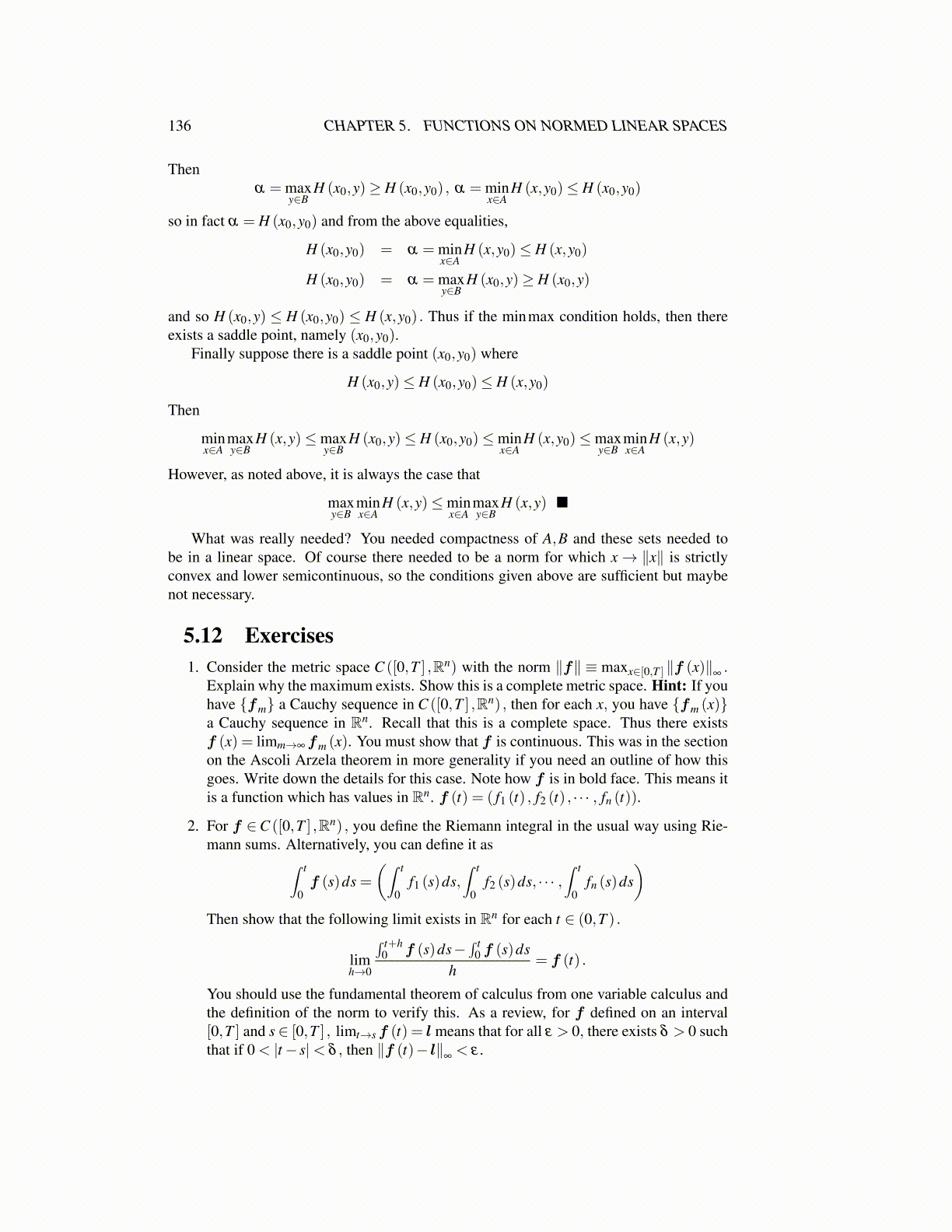
136 CHAPTER 5. FUNCTIONS ON NORMED LINEAR SPACES
Thenα = max
y∈BH (x0,y)≥ H (x0,y0) , α = min
x∈AH (x,y0)≤ H (x0,y0)
so in fact α = H (x0,y0) and from the above equalities,
H (x0,y0) = α = minx∈A
H (x,y0)≤ H (x,y0)
H (x0,y0) = α = maxy∈B
H (x0,y)≥ H (x0,y)
and so H (x0,y) ≤ H (x0,y0) ≤ H (x,y0) . Thus if the minmax condition holds, then thereexists a saddle point, namely (x0,y0).
Finally suppose there is a saddle point (x0,y0) where
H (x0,y)≤ H (x0,y0)≤ H (x,y0)
Then
minx∈A
maxy∈B
H (x,y)≤maxy∈B
H (x0,y)≤ H (x0,y0)≤minx∈A
H (x,y0)≤maxy∈B
minx∈A
H (x,y)
However, as noted above, it is always the case that
maxy∈B
minx∈A
H (x,y)≤minx∈A
maxy∈B
H (x,y) ■
What was really needed? You needed compactness of A,B and these sets needed tobe in a linear space. Of course there needed to be a norm for which x→ ∥x∥ is strictlyconvex and lower semicontinuous, so the conditions given above are sufficient but maybenot necessary.
5.12 Exercises1. Consider the metric space C ([0,T ] ,Rn) with the norm ∥f∥ ≡ maxx∈[0,T ] ∥f (x)∥
∞.
Explain why the maximum exists. Show this is a complete metric space. Hint: If youhave {fm} a Cauchy sequence in C ([0,T ] ,Rn) , then for each x, you have {fm (x)}a Cauchy sequence in Rn. Recall that this is a complete space. Thus there existsf (x) = limm→∞fm (x). You must show that f is continuous. This was in the sectionon the Ascoli Arzela theorem in more generality if you need an outline of how thisgoes. Write down the details for this case. Note how f is in bold face. This means itis a function which has values in Rn. f (t) = ( f1 (t) , f2 (t) , · · · , fn (t)).
2. For f ∈C ([0,T ] ,Rn) , you define the Riemann integral in the usual way using Rie-mann sums. Alternatively, you can define it as∫ t
0f (s)ds =
(∫ t
0f1 (s)ds,
∫ t
0f2 (s)ds, · · · ,
∫ t
0fn (s)ds
)Then show that the following limit exists in Rn for each t ∈ (0,T ) .
limh→0
∫ t+h0 f (s)ds−
∫ t0 f (s)ds
h= f (t) .
You should use the fundamental theorem of calculus from one variable calculus andthe definition of the norm to verify this. As a review, for f defined on an interval[0,T ] and s ∈ [0,T ] , limt→sf (t) = l means that for all ε > 0, there exists δ > 0 suchthat if 0 < |t− s|< δ , then ∥f (t)− l∥
∞< ε .